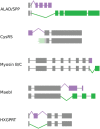Alternative Splicing in Apicomplexan Parasites
- PMID: 30782661
- PMCID: PMC6381282
- DOI: 10.1128/mBio.02866-18
Alternative Splicing in Apicomplexan Parasites
Abstract
Alternative splicing is a widespread, essential, and complex component of gene regulation. Apicomplexan parasites have long been recognized to produce alternatively spliced transcripts for some genes and can produce multiple protein products that are essential for parasite growth. Recent approaches are now providing more wide-ranging surveys of the extent of alternative splicing; some indicate that alternative splicing is less widespread than in other model eukaryotes, whereas others suggest levels comparable to those of previously studied groups. In many cases, apicomplexan alternative splicing events appear not to generate multiple alternative proteins but instead produce aberrant or noncoding transcripts. Nonetheless, appropriate regulation of alternative splicing is clearly essential in Plasmodium and Toxoplasma parasites, suggesting a biological role for at least some of the alternative splicing observed. Several studies have now disrupted conserved regulators of alternative splicing and demonstrated lethal effects in apicomplexans. This minireview discusses methods to accurately determine the extent of alternative splicing in Apicomplexa and discuss potential biological roles for this conserved process in a phylum of parasites with compact genomes.
Keywords: Plasmodium; RNA splicing; Toxoplasma; apicomplexan parasites; posttranscriptional control mechanisms.
Copyright © 2019 Yeoh et al.
Figures




Similar articles
-
Alternative splicing mechanisms orchestrating post-transcriptional gene expression: intron retention and the intron-rich genome of apicomplexan parasites.Curr Genet. 2016 Feb;62(1):31-8. doi: 10.1007/s00294-015-0506-x. Epub 2015 Jul 21. Curr Genet. 2016. PMID: 26194054
-
Phylogeny and evolution of apicoplasts and apicomplexan parasites.Parasitol Int. 2015 Jun;64(3):254-9. doi: 10.1016/j.parint.2014.10.005. Epub 2014 Oct 14. Parasitol Int. 2015. PMID: 25451217 Review.
-
Direct Nanopore Sequencing of mRNA Reveals Landscape of Transcript Isoforms in Apicomplexan Parasites.mSystems. 2021 Mar 9;6(2):e01081-20. doi: 10.1128/mSystems.01081-20. mSystems. 2021. PMID: 33688018 Free PMC article.
-
A serine-arginine-rich (SR) splicing factor modulates alternative splicing of over a thousand genes in Toxoplasma gondii.Nucleic Acids Res. 2015 May 19;43(9):4661-75. doi: 10.1093/nar/gkv311. Epub 2015 Apr 13. Nucleic Acids Res. 2015. PMID: 25870410 Free PMC article.
-
Noncoding RNAs in Apicomplexan Parasites: An Update.Trends Parasitol. 2020 Oct;36(10):835-849. doi: 10.1016/j.pt.2020.07.006. Epub 2020 Aug 20. Trends Parasitol. 2020. PMID: 32828659 Free PMC article. Review.
Cited by
-
Unravelling the sexual developmental biology of Cystoisospora suis, a model for comparative coccidian parasite studies.Front Cell Infect Microbiol. 2023 Oct 25;13:1271731. doi: 10.3389/fcimb.2023.1271731. eCollection 2023. Front Cell Infect Microbiol. 2023. PMID: 37953800 Free PMC article.
-
The multifaceted roles of Myb domain-containing proteins in apicomplexan parasites.Curr Opin Microbiol. 2023 Dec;76:102395. doi: 10.1016/j.mib.2023.102395. Epub 2023 Oct 30. Curr Opin Microbiol. 2023. PMID: 37866202 Free PMC article. Review.
-
A tale of two parasites: a glimpse into the RNA methylome of patient-derived Plasmodium falciparum and Plasmodium vivax isolates.Malar J. 2025 May 2;24(1):139. doi: 10.1186/s12936-025-05376-9. Malar J. 2025. PMID: 40316999 Free PMC article.
-
Deletion of splicing factor Cdc5 in Toxoplasma disrupts transcriptome integrity, induces abortive bradyzoite formation, and prevents acute infection in mice.Nat Commun. 2025 Apr 22;16(1):3769. doi: 10.1038/s41467-025-58805-3. Nat Commun. 2025. PMID: 40263328 Free PMC article.
-
Transcriptomic complexity of the human malaria parasite Plasmodium falciparum revealed by long-read sequencing.PLoS One. 2022 Nov 4;17(11):e0276956. doi: 10.1371/journal.pone.0276956. eCollection 2022. PLoS One. 2022. PMID: 36331983 Free PMC article.
References
-
- Le Roch KG, Johnson JR, Florens L, Zhou Y, Santrosyan A, Grainger M, Yan SF, Williamson KC, Holder AA, Carucci DJ, Yates JR, Winzeler EA. 2004. Global analysis of transcript and protein levels across the Plasmodium falciparum life cycle. Genome Res 14:2308–2318. doi:10.1101/gr.2523904. - DOI - PMC - PubMed
-
- Mair GR, Lasonder E, Garver LS, Franke-Fayard BM, Carret CK, Wiegant JC, Dirks RW, Dimopoulos G, Janse CJ, Waters AP. 2010. Universal features of post-transcriptional gene regulation are critical for Plasmodium zygote development. PLoS Pathog 6:e1000767. doi:10.1371/journal.ppat.1000767. - DOI - PMC - PubMed
Publication types
MeSH terms
LinkOut - more resources
Full Text Sources
